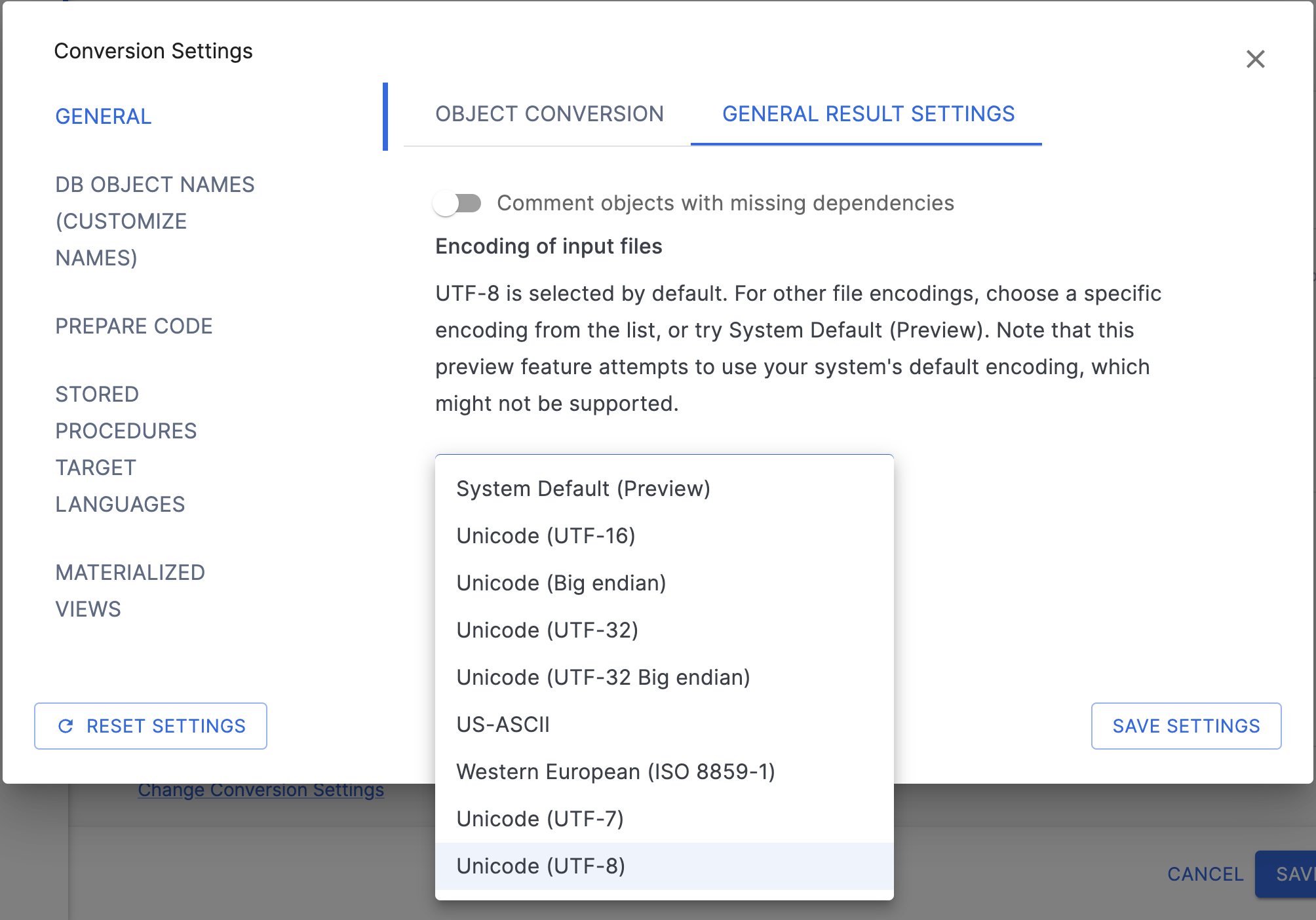SnowConvert AI :一般的な変換設定¶
ファイルのエンコーディング設定¶
SnowConvert AI のこの設定は、ツールがソースファイル内のテキストをどのように読み、解釈するかを決定します。すべての文字、特にアクセント付き文字、記号、またはさまざまな言語のテキストが変換中に正しく処理されるようにするには、正しいエンコードを選択することが重要です。デフォルトでは、SnowConvert AI は UTF-8 を使用します。

エンコーディングを手動で選択する
ドロップダウンメニューから特定のエンコーディングを選択することで、この自動処理を上書きすることができます。手動でエンコーディングを選択した場合(UTF-8 を明示的に選択した場合でも)、SnowConvert AI は選択したエンコーディングのみを使用してファイルを読み込みます。
利用可能なエンコーディングオプション
ドロップダウンリストを使用すると、SnowConvert AI で次のいずれかの特定のエンコーディングを使用するように強制できます。
| Code Page | Name | Display Name |
|---|---|---|
| 1200 | utf-16 | Unicode |
| 1201D | unicodeFFFE | Unicode (Big endian) |
| 12000 | utf-32 | Unicode (UTF-32) |
| 12001 | utf-32BE | Unicode (UTF-32 Big endian) |
| 20127 | us-ascii | US-ASCII |
| 28591 | iso-8859-1 | Western European (ISO) |
| 65000 | utf-7 | Unicode (UTF-7). Not available in .NET 5 |
| 65001 | utf-8 | Unicode (UTF-8). Default encoding |
システムデフォルト(プレビュー) の理解
システムデフォルト(プレビュー) を選択する場合、SnowConvert AI は柔軟なアプローチを用います。
まず、各入力ファイルの特定の文字エンコーディングを自動的に検出しようとします。
自動検出でエンコーディングが識別されない場合、SnowConvert AI は
UTF-8を使って処理を進めます。これは非常に広範な文字を処理でき、最近のファイルでは一般的です。フォールバックとして、
UTF-8の解釈が、UTF-8 で有効でない文字を見つけたために失敗した場合、SnowConvert AI は、お使いのコンピューターのデフォルトのシステムエンコーディングの使用を試みます。
この動作は実験的なものであるため、「プレビュー」と表示されています。システムのデフォルトは、コンピューターやオペレーティングシステムによって大きく異なることがあり、一貫性のない結果やサポートされていないエンコーディングにつながる可能性があります。
推奨事項
テキストの解釈に関連するエラーが発生したり、結果に文字化けが見られる場合は、正しいエンコーディングを手動で選択するのが最善の解決策です。ファイルが特定の形式(西ヨーロッパ など)を使用していることがわかっている場合は、それを選択してください。核心が持てないがエンコードに問題があると思われる場合、最近のファイルでは最も一般的な標準である UTF-8 を明示的に選択するのが良い出発点になることが多いです。
マテリアライズドビューの変換設定¶
このページでは、翻訳時にマテリアライズドビュー(Teradataでは結合インデックス)をダイナミックテーブルに変換するパラメーターをカスタマイズするために必要なオプションを示します。


マテリアライズドビュー、またはTeradataのJoin Indexの全機能を維持するために、SnowConvert AI は1対1のマテリアライズドビューを作成したり、Join Indexをマテリアライズドビューに変換したりする代わりに、動的テーブルを生成します。Snowflakeには、他のシステムのマテリアライズドビューで利用可能な特定の構成オプションがないため、このアプローチが必要です。
Snowflakeのマテリアライズドビュー制限の詳細については、 マテリアライズドビューの制限 をご参照ください。
変換¶
ここで定義された設定は、変換処理中に生成されたダイナミックテーブルのすべてのインスタンスに適用されます。
ダイナミックテーブル変換設定:
ターゲットラグ: この設定では、ダイナミックテーブルのコンテンツがベーステーブルの更新に遅れる最大許容時間を指定します。たとえば、これを5分にセットすると、ダイナミックテーブルのデータがベーステーブルの更新から5分以上遅れないようになります。
ウェアハウスこの設定では、動的テーブルを更新するためのコンピューティングリソースを提供するウェアハウスの名前を指定します。動的テーブルを作成するには、このウェアハウスに USAGE 権限が必要です。デフォルトでは、SnowConvert AI はプレースホルダーの値を使用します。
詳細情報については、Snowflake動的テーブル ドキュメント をご参照ください。
Next steps for Amazon Redshift databases¶
For Amazon Redshift databases, you can use SnowConvert AI to complete the following tasks after conversion: